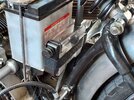I had a standard breather setup with an extended hose to a container under the UFM. It was unhandy to empty it when needed, so I am trying an over-the-engine system. The catch can is a plastic hip flask on its side with a vent hole, supported by a pair of light brackets behind the battery.
You are using an out of date browser. It may not display this or other websites correctly.
You should upgrade or use an alternative browser.
You should upgrade or use an alternative browser.
ET: Engine (Twin) Breather Catch Can
- Thread starter bmetcalf
- Start date
I found a beautiful little alloy cylinder at a car wrecking yard. It's about 60mm diameter by 125 mm. long. Maybe it was a vacuum reservoir or something. It even has a neat 10mm. spigot. I bored a hole in the top to atmosphere and plumbed in a 1/4" B.S.P. drain cock at the bottom I mounted it on the front of the R.F.M. between the curves with straps and springs. It may have come from a Renault, Peugeot or Volvo and it was originally fitted on the panel that mounts the lights and bonnet catch
I use a alloy water bottle from 'Go outside' I always ask them how come you have a list of every outdoor pursuit on a 20 foot sign outside your store but never have motorcycling on it?
Regs say it has to be 500cc thats a pity 10cc would do with our PCV valves!

Regs say it has to be 500cc thats a pity 10cc would do with our PCV valves!
A non-sticky one-way-valve is essential in a breather line for minimizing the amount of air exiting the system. An open hose is a poor idea as you will not have a little amount of vacuum in the engine for helping in sealing doubtful places like the dynamo "slinger" plate and all. Also you´d need a larger catch tank with that amount of air from open hoses.
Vic
Vic
"A non-sticky one-way-valve is essential in a breather line for minimizing the amount of air exiting the system"
I would suggest that rather than the valve limiting the air exiting the system it does the opposite it should limit the air entering the system at the risk of repeating myself the 'french letter experiment' is worth repeating, fixed to a PCV valve outlet it blows up and then stabilises as a balloon. Once a vacuum is established in the crankcase very little air moved in the pipe. if you arrange the PCV valve to stop air exiting the crankcase ie backwards I think you will find some oily results.
I would suggest that rather than the valve limiting the air exiting the system it does the opposite it should limit the air entering the system at the risk of repeating myself the 'french letter experiment' is worth repeating, fixed to a PCV valve outlet it blows up and then stabilises as a balloon. Once a vacuum is established in the crankcase very little air moved in the pipe. if you arrange the PCV valve to stop air exiting the crankcase ie backwards I think you will find some oily results.
Sorry, Vibrac, my brain fart ! Certainly with a one way valve you want to stop air returning into engine , air , that was just expelled from it. Same idea like with the timed breather but not critical about timing. With a real working valve there is no need for these huge hoses we see on Vincents all too often. I would never be willing to stick them on my bikes.
Vic
Vic
IIRC, Steve Hamel told me that he connected a manometer to the breather line on a new motor and after startup, it showed very low pressure, indicating low flow. This supports having a small line after the pcv valve. However, I'm keeping my big hose.
Just start your engine and hold your hand behind the breather hose for feel. There is very little air actually exiting from there with a healthy engine, provided there are no other leaks which compromise the one-way valve or timed breather.
Vic
Vic

